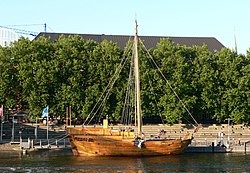 The Bremen Cog at German Maritime Museum, 2021 | |
| History | |
|---|---|
| Laid down | 1380s |
| Fate | Sank while under construction, salvaged between 1962 and 1965 |
| Status | Currently a museum ship |
| General characteristics | |
| Class & type | Cog |
| Tonnage | 90 to 130 tons |
| Length | 23.27 m (76.35 ft) |
| Beam | 7.62 m (25.0 ft) |
| Sail plan | Square-rigged |
| Notes | Dimensions taken from exhibition notes at the Hanseatic Museum in Bergen |
The Bremen cog is a well-preserved wreck of a cog dated to 1380, found in 1962 in Bremen. Today, it is displayed at the German Maritime Museum in Bremerhaven as one of the main features. Three nearly identical replicas of this cog have been built: Ubena von Bremen, Hansekogge, and Roland von Bremen.


